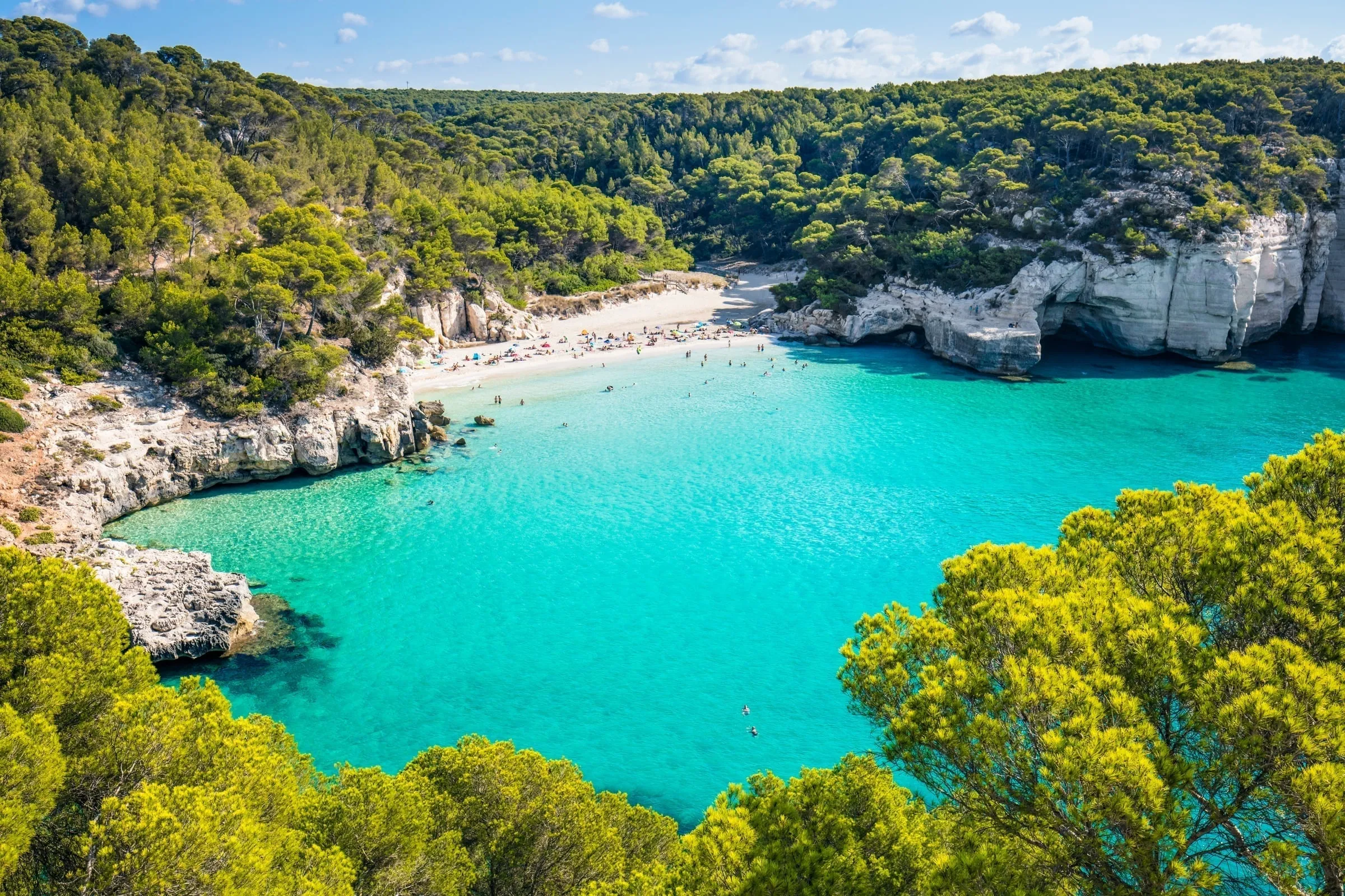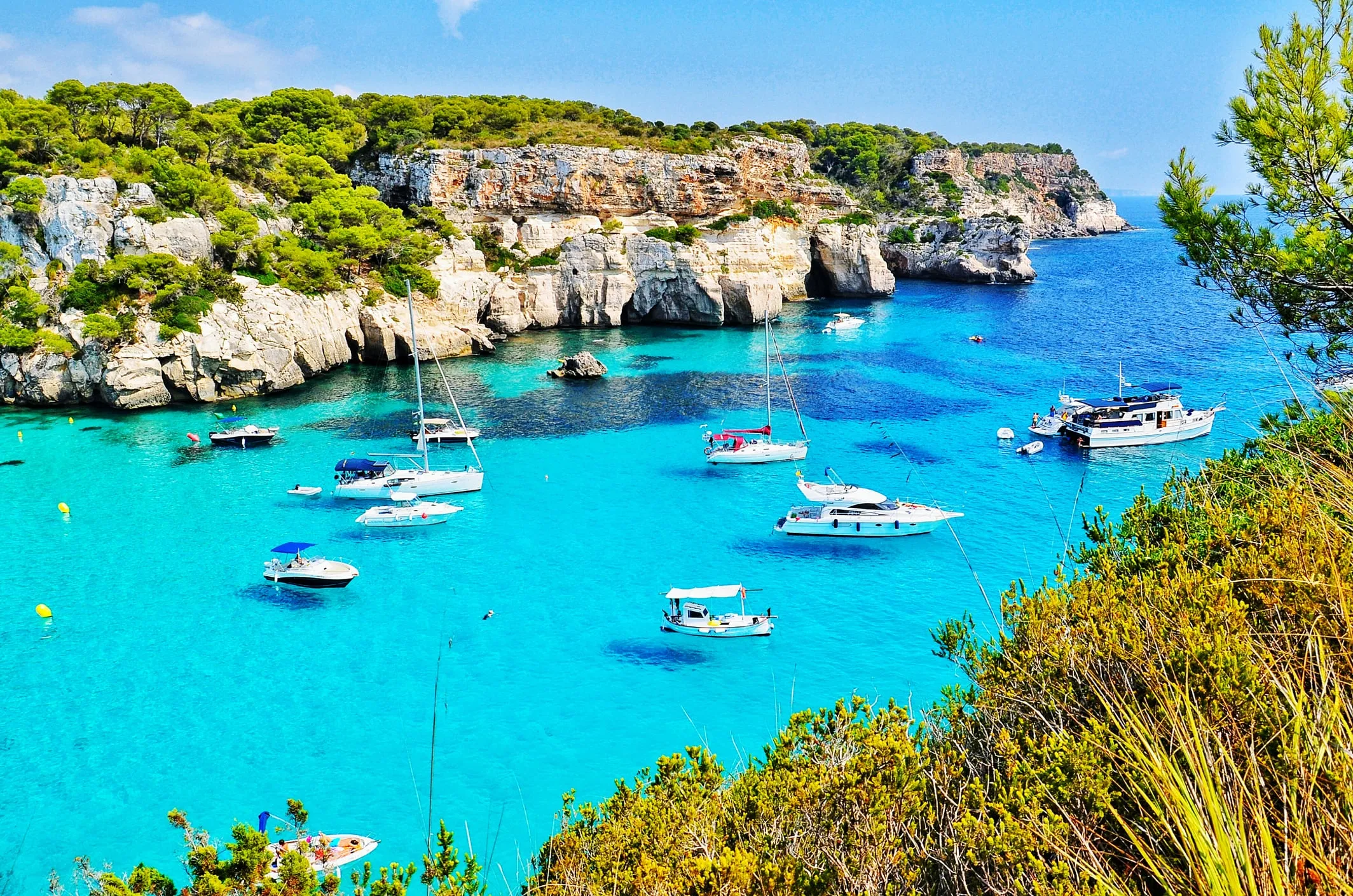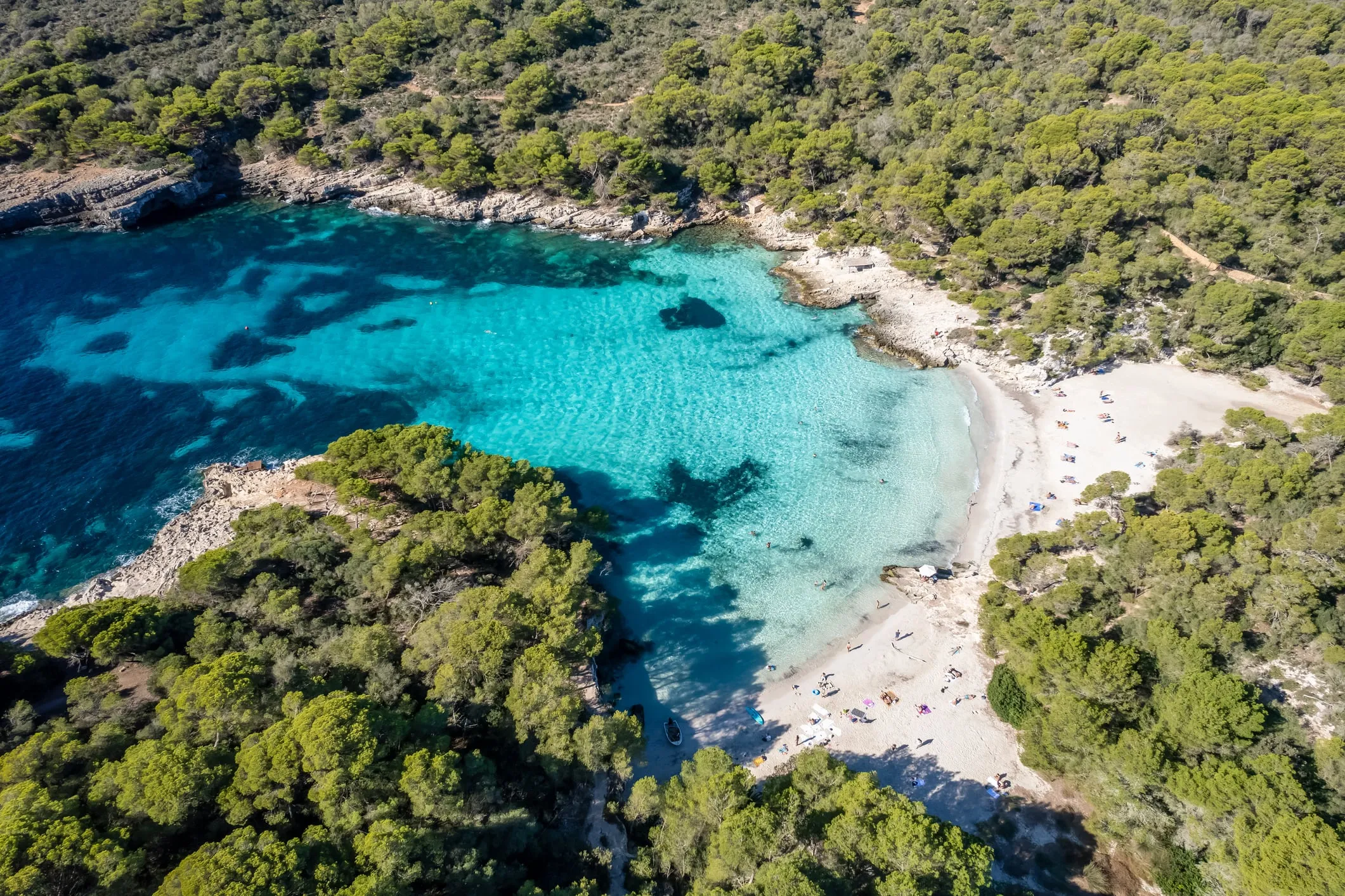
At 6:45am, before the rental cars arrive from Mahón, Cala Mitjana belongs to three local swimmers who’ve been coming here since the 1960s, when the dirt road required a Land Rover and the beach had no name on maps. They float in water so clear you can count sea urchins at 5 meters depth, their morning ritual timed to finish before the first Instagram photographer arrives at 8am to capture “undiscovered” Menorca.
The southern coast of Menorca cuts into limestone cliffs with surgical precision, creating a series of calas – narrow inlets where pine forests tumble down to sand beaches and water that shifts from turquoise to sapphire depending on the posidonia meadows below. These aren’t beaches; they’re geological accidents that happen to be perfect for swimming, each one a 10-minute YouTube video waiting to go viral and ruin everything locals love about them.
Understanding the Southern Cala System
The Limestone Canvas
Menorca’s south coast is Miocene limestone laid down 20 million years ago when this was seafloor. The rock erodes in layers, creating the stepped cliffs that make perfect diving platforms and the underwater caves where groupers hide from spear fishermen. The calas form where ancient rivers cut through limestone to reach the sea, their valleys now flooded to create these narrow beach pockets.
The limestone determines everything: the white sand (pulverized rock), the turquoise water (light reflecting off white seafloor), the lack of development (building on limestone costs fortunes), and the walking paths (following rock strata). Understanding the geology helps you understand why these beaches exist and why they’ll survive long after Magaluf’s concrete crumbles.
The Access Hierarchy
Menorca’s southern calas divide into three categories based on access:
Drive-to Beaches (Parking lot to sand):
- Cala Galdana: Resort development, everything available, everyone there
- Cala en Porter: Cliff-flanked beach with cave bar
- Son Bou: 3km of sand, naturist sections, archaeological sites
- Binigaus: Nudist beach accessed through Son Bou
Walk-in Beaches (10-30 minute trails):
- Cala Mitjana & Mitjaneta: 15 minutes from parking
- Cala Trebalúger: 30 minutes from Cala Mitjana or 45 from parking
- Cala Fustam: 25 minutes through private land (sometimes closed)
- Cala Escorxada: 20 minutes if you know the unmarked turn
Expedition Beaches (1+ hour hikes or boat only):
- Cala Pilar: 40-minute cliff scramble
- Cala Pregonda: 30 minutes from Binimel·là
- Calas Macarella/Macarelleta: 30 minutes from parking (summer bus required)
- Cala Turqueta: 15 minutes from lottery parking
The Star Calas: Where Everyone Goes
Cala Macarella & Macarelleta
The Instagram Twins
These adjacent coves became Menorca’s most famous beaches after appearing in every Mediterranean travel article since 2010. Macarella, the larger cove, has a beach bar serving €15 paella and €5 Estrella. Macarelleta, reached by a cliff path that terrifies parents, offers nude sunbathing and cliff jumping from 5-meter platforms.
Access Intelligence
- Summer (June-September): Cars banned, shuttle bus from Ciutadella €3 return
- Parking: €10 at private lot 1.3km away
- Arrival sweet spot: Before 9am or after 5pm
- Boat access: Anchor in 5m sand patches, swim to beach
- Secret: Walk 15 minutes past Macarelleta to empty coves
Reality Check: By 11am in July, Macarelleta has 300 bodies on a 50-meter beach. The water stays pristine because currents flush the bay twice daily, but the human density reaches Manhattan subway levels. The cliff jumping looks fun until you see teenagers with spinal injuries being helicoptered out twice per summer.
Cala Mitjana & Mitjaneta
The Accessible Perfection
Mitjana offers Menorca’s best effort-to-reward ratio: 15-minute walk on a marked path to a 100-meter beach with limestone cliffs, cave swimming, and a beach bar that closes at sunset. Sister beach Mitjaneta, 5 minutes further, halves the crowds for minimal extra effort.
Logistics
- Parking: €5 at farm lot, €10 for all day
- Trail: Rocky but manageable in flip-flops (don’t though)
- Beach bar: Bocadillos €6, beer €3, closes 7pm
- Best spot: Left side under trees for afternoon shade
- Cave swim: Right side, 50m swim to cathedral-sized cavern
The walk from parking follows a dry riverbed through farm land where horses graze on stubble. The smell of wild fennel mixes with pine resin. The first beach view from the cliff edge generates involuntary gasps – everyone stops to photograph the same angle, the one you’ve seen on postcards.

The Instagram twins from above: Macarella (left) with its beach bar and Macarelleta (right) with cliff jumping platforms. The 200m path connecting them becomes a highway by 10am. Those tiny dots in the water? People discovering the caves.
Cala Turqueta
The Parking Lottery
Turqueta might be Menorca’s most beautiful beach, but accessing it requires winning the parking lottery. The single-lane dirt road ends at a 50-car lot that fills by 8:30am in summer. No parking means a 3km walk from the main road unless you arrive by boat, bicycle, or determination.
The beach deserves its reputation: 100 meters of white sand bookended by cliffs, water graduating from transparent to turquoise to navy, pine forest providing shade, no development visible. The swimming is perfect – sandy bottom, gradual depth, protection from waves.

Cala Turqueta at 7:30am, before the parking lottery begins: The horseshoe bay that launched a thousand screensavers. Those rocks on the right hide caves where fish congregate at dawn. The left cliff has a 4-meter jump that nobody mentions in guidebooks.
Survival Tactics
- Arrive by 8am or after 6pm
- Bring everything – no services
- Shade disappears after 2pm
- Snorkeling best along right cliff
- Nudists colonize far left corner
Cala Galdana
The Developed Option
Galdana sold its soul for parking lots and apartment blocks, but the beach remains spectacular: 450 meters of sand in a shell-shaped bay, cliffs topped with hotels, water shallow enough for toddlers. This is Menorca’s only southern beach with full services – restaurants, supermarkets, ATMs, medical center, regret.
Galdana Realities
- Parking: €2/hour in summer, free off-season
- Beach services: Loungers €15, umbrellas €10, kayaks €20/hour
- Restaurants: Tourist prices but decent quality
- Best swimming: Eastern end away from boat traffic
- Escape route: Cliff paths to Macarella (west) or Mitjana (east)
The morning in Galdana belongs to hotel guests doing water aerobics. By noon, day-trippers from Ciutadella triple the population. By evening, the beach empties except for families whose children refuse to leave the water.
The Hidden Calas: Where Locals Go
Cala Trebalúger
The River Beach
Trebalúger requires commitment: 45 minutes walking from the parking area, following the Camí de Cavalls through farmland, past the ruins of a defensive tower, down a ravine where a freshwater stream meets the sea. The effort filters out casual tourists, leaving a beach where you might be alone in shoulder season.
The freshwater stream creates Menorca’s only river swimming – follow it inland through caves where the water stays at 18°C year-round. The beach itself is small, maybe 40 meters, with coarse sand and reliability issues (storms can remove the sand entirely, returning it months later).
Access Options
- From Cala Mitjana: 30-minute coastal path
- From parking: 45 minutes through farms
- By kayak: 2 hours from Galdana
- Permission required: Cross private land, gates usually open
Cala Fustam
The Abandoned Paradise
Fustam exists in legal limbo – accessible via private property whose owners periodically close access, forcing visitors to kayak or swim from Escorxada. When open, a 25-minute walk through pine forest leads to an untouched cove with 30 meters of sand and vertical cliffs creating perfect acoustics for the sound of nothing.
The beach has no services, no shade after noon, no easy swimming (rocky entry), no crowds because most people can’t find it. The unmarked trail starts behind the Cala Escorxada parking area, follows a dry streambed, splits three times (always go right), and emerges at a beach that looks computer-generated.
Cala Escorxada
The Local Secret
Escorxada flies under radar because its access road looks private and its beach disappears at high tide. Park at the unmarked lot (free), walk 200 meters past “Prohibido” signs that don’t mean you, arrive at a narrow beach where Menorcan families have claimed the same spots since Franco.
The swimming requires walking on rocks until waist-deep, then perfect sand bottom. The snorkeling along the eastern cliff reveals octopus gardens and schools of silver fish that part like curtains. No services, no shade, no tourists who need either.
Binigaus
The Naturist Institution
Binigaus, accessed through Son Bou or via a rough dirt road, has been Menorca’s unofficial nudist beach since the 1970s. The beach stretches 500 meters below red cliffs that provide morning shade and photogenic backgrounds for careful photography angles.
The nudist protocol is relaxed – textile swimmers mix with naturists without conflict. The beach bar (summer only) serves everyone regardless of clothing status. The swimming is excellent once you pass the rock shelf at entry. The crowd includes German retirees, Spanish families, and confused British tourists who keep their suits on.
The Logistics of Cala Hopping
Transportation Strategies
Rental Car (€35-50/day): Essential for freedom but parking is warfare. Arrive before 8:30am or after 5pm. Many roads require compact cars. GPS fails regularly; download offline maps.
Scooter (€25-35/day): Perfect for solo travelers. Parks anywhere. Terrifying on main roads. Useless for carrying beach gear.
Bicycle (€15-20/day): E-bikes make distances manageable. Dedicated paths to some beaches. Theft risk at isolated parking areas.
Bus + Walk Limited routes serve only Galdana and Son Bou. Requires planning and patience.
Boat Charter (€150-400/day): Access boat-only beaches. Anchor and swim to shore. Include snorkel gear and lunch.
The Daily Beach Schedule
6:30-8:30am: Locals and early birds. Perfect light, empty beaches, cool temperatures.
9-11am: Arrival rush. Parking fills, tour boats anchor, crowds build.
11am-2pm: Peak saturation. Maximum density, minimal comfort, social media prime time.
2-4pm: Brutal sun. Shade disappears, families leave, hardcore tanners remain.
4-6pm: Second wave. Day-trippers depart, evening swimmers arrive, golden hour approaches.
6-8pm: Magic time. Crowds gone, light perfect, water warm, parking available.
After 8pm: Locals return for evening swims, sunset watchers gather, beaches return to nature.
Essential Gear
Always Bring
- Water (2 liters minimum)
- Snorkel gear (€15 at any shop)
- Reef-safe sunscreen (regular banned soon)
- Beach umbrella (no shade at most calas)
- Snacks (no services at wild beaches)
Smart Additions
- Water shoes (rocky entries common)
- Dry bag (for swimming to caves)
- First aid kit (nearest hospital 45 minutes)
- Offline maps (phone signal unreliable)
- Cash (beach bars don’t take cards)
Seasonal Beach Intelligence
Summer (June-September)
Crowds maximum, prices peak, water perfect at 26°C. Parking warfare requires military strategy. Beach bars open. Jellyfish appear with easterly winds. Posidonia smell strong but indicates healthy ecosystem.
Spring (April-May)
Water cold (18°C) but swimmable. Wildflowers carpet cliff paths. Beaches empty weekdays. Rain possible but brief. Best hiking weather.
Autumn (October-November)
Water warm (22°C) from summer heat retention. Crowds vanish after October 15. Beach bars close. Storms possible but dramatic. Locals reclaim beaches.
Winter (December-March)
Beaches empty except for hikers. Swimming for hardy (15°C water). Dramatic storms reshape beaches. Perfect for photography. Some access roads flood.
The Environmental Reality
The Posidonia Problem
The seagrass washing onto beaches isn’t pollution – it’s Posidonia oceanica, a protected marine plant that produces oxygen, prevents erosion, and creates the clear water everyone loves. Hotels that remove it face fines. Tourists who complain reveal ignorance.
The smell in summer comes from decomposition, peaks in August, indicates ecosystem health. Swim through it (harmless), walk on it (natural cushion), don’t expect its removal (illegal).
The Overcrowding Crisis
Menorca’s beaches reached carrying capacity around 2015. Now they exceed it daily June through September. The limestone can’t support more parking. The sewage systems can’t handle more toilets. The beaches physically can’t fit more bodies.
Solutions being tested:
- Parking restrictions (Turqueta, Macarella)
- Shuttle buses (reducing car access)
- Daily visitor limits (proposed, not implemented)
- Higher parking fees (€10-15 coming)
- Marine reserves (anchoring restrictions)
Beach Bar Culture
The Chiringuito Economy
Beach bars operate May through October, transforming from wooden shacks to EU-regulated restaurants serving the same menus:
- Pa amb oli: €8-12 (tomato bread with toppings)
- Paella: €15-18 per person (minimum 2)
- Fish of the day: €18-25 (usually farmed)
- Sangria: €18/liter (tourist trap)
- Pomada: €4-6 (gin with lemonade)
The quality varies wildly. Mitjana’s bar serves honest bocadillos. Galdana’s beachfront charges €25 for frozen paella. The rule: If they have photos of food, eat elsewhere.
The Sunset Ritual
Beach bars with western exposure become sunset theaters. Cala en Porter’s bar charges €8 for beer during sunset. Son Bou’s chiringuitos require dinner reservations for sunset tables. The smart money brings its own drinks, watches from the rocks, saves €40.
Navigation Failures to Avoid
Mistakes That Ruin Days
- Following Google Maps to “shorter” routes (end at cliffs)
- Arriving at 11am expecting parking
- Forgetting water on hour-long hikes
- Wearing flip-flops on rocky trails
- Believing “5-minute walk” from parking
- Swimming near boat channels
- Touching sea urchins
- Leaving valuables visible in cars
- Expecting phone signal
- Trusting weather apps (microclimate chaos)
The Deeper Beach Truth
Menorca’s southern calas represent the last accessible paradise in the overdeveloped Mediterranean. They survive because limestone geology prevents construction, local government resists development, and UNESCO Biosphere designation provides protection.
But paradise has limits. Every Instagram post brings more pressure. Every travel article adds visitors. Every summer breaks records. The beaches that took millions of years to form can’t adapt to millions of visitors in decades.
The ethical visitor comes early or late, brings everything needed, takes everything brought, respects posidonia, doesn’t geo-tag photos, understands that paradise shared carelessly becomes paradise lost.
Come for turquoise water and limestone cliffs. But understand you’re visiting someplace fragile, where beauty depends on restraint. The secret to Menorca’s calas isn’t finding them – GPS solved that. It’s visiting them like they matter, because to the three swimmers floating at dawn in Cala Mitjana, they’re not just beaches. They’re home.
